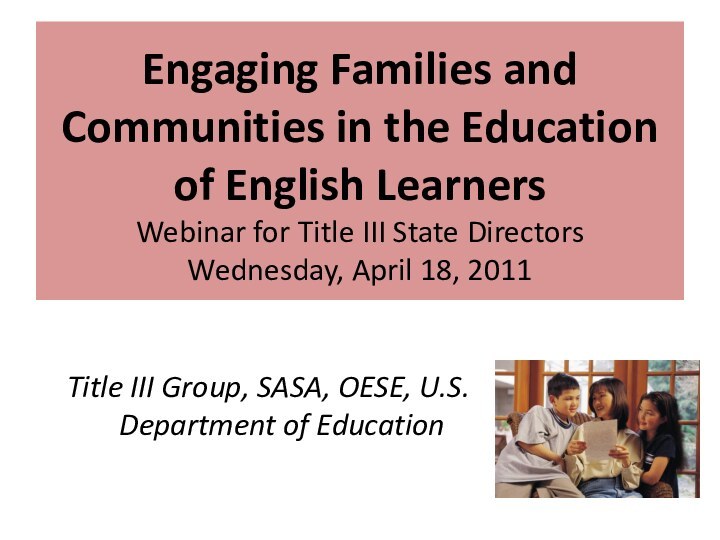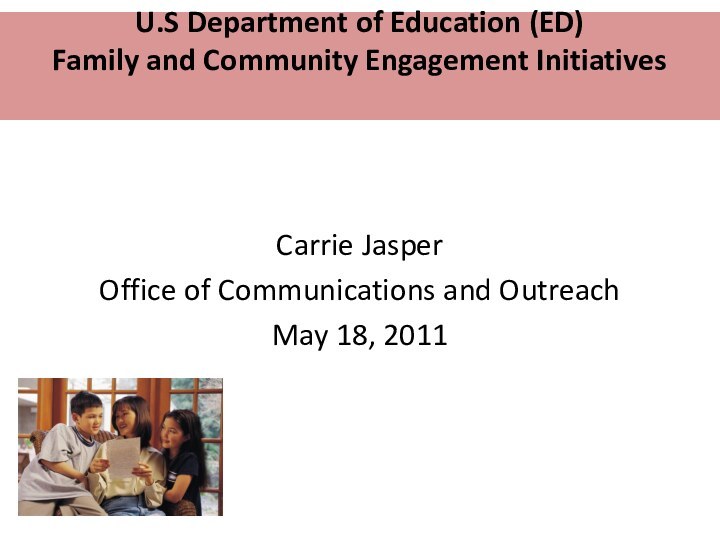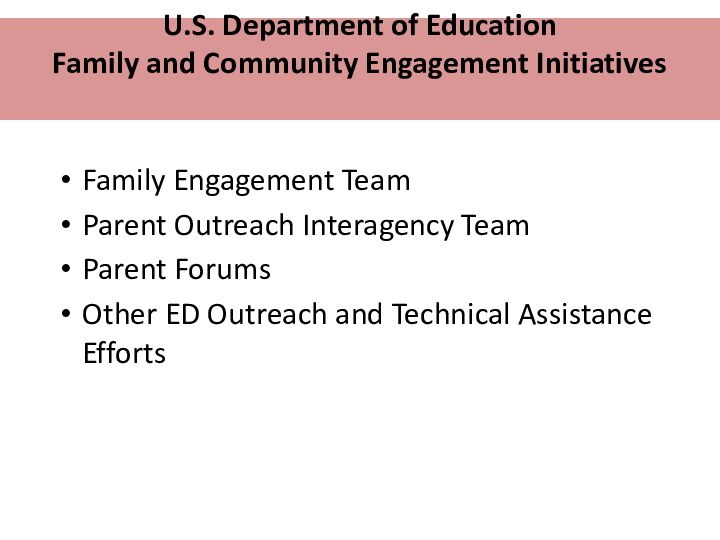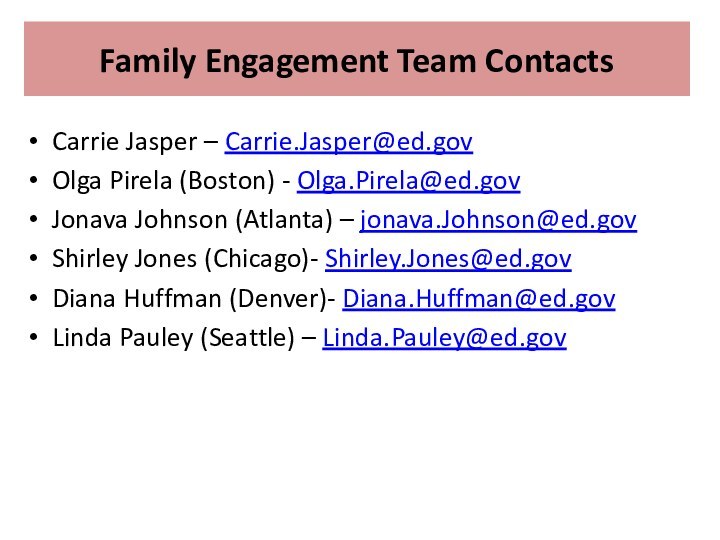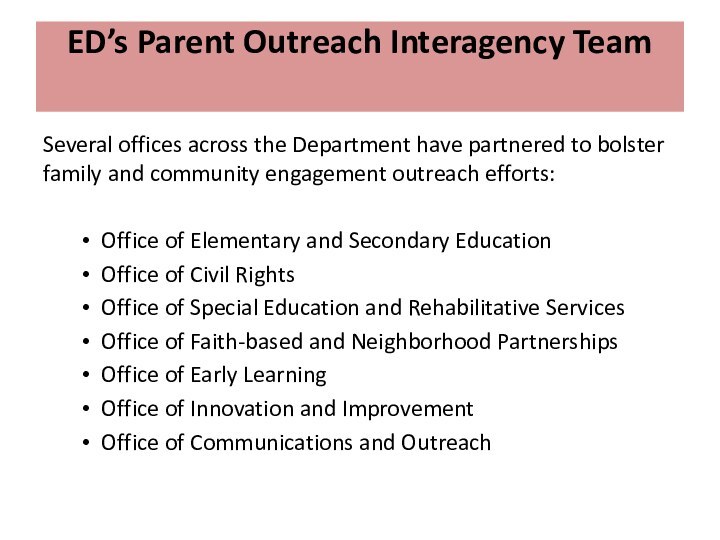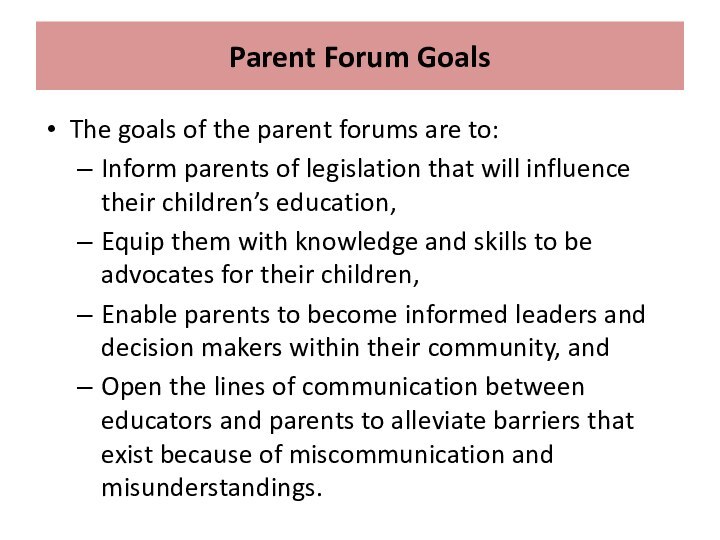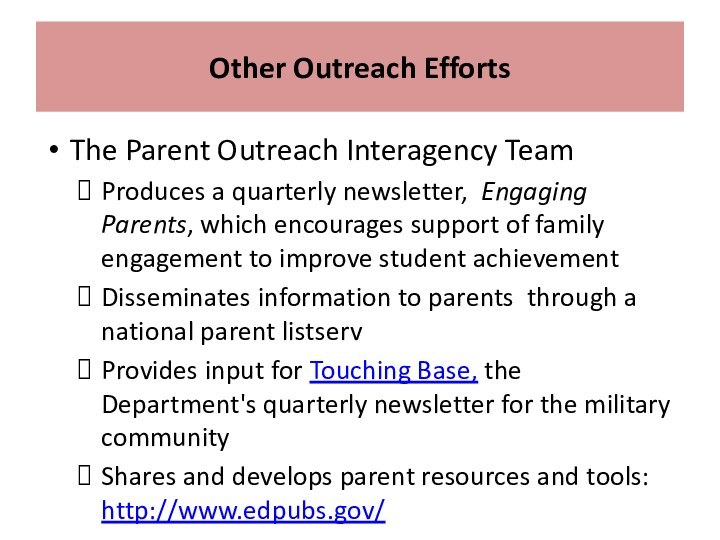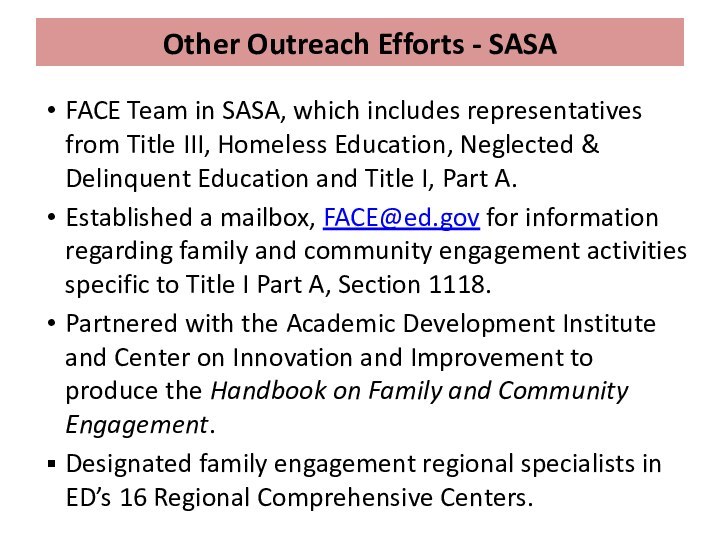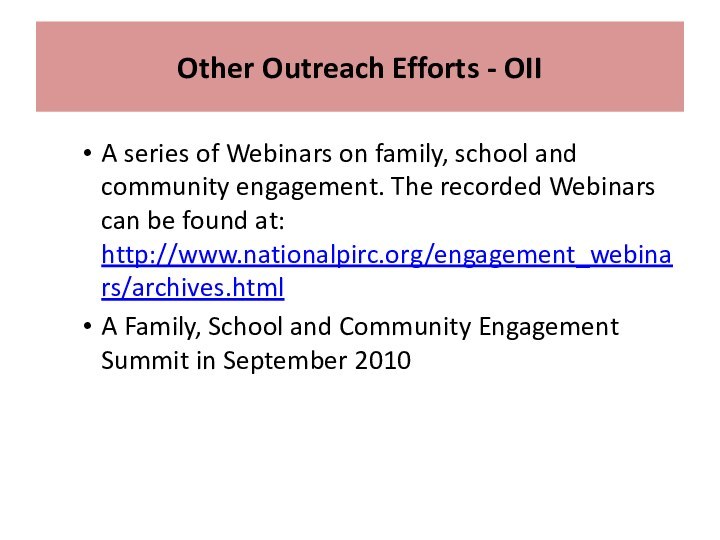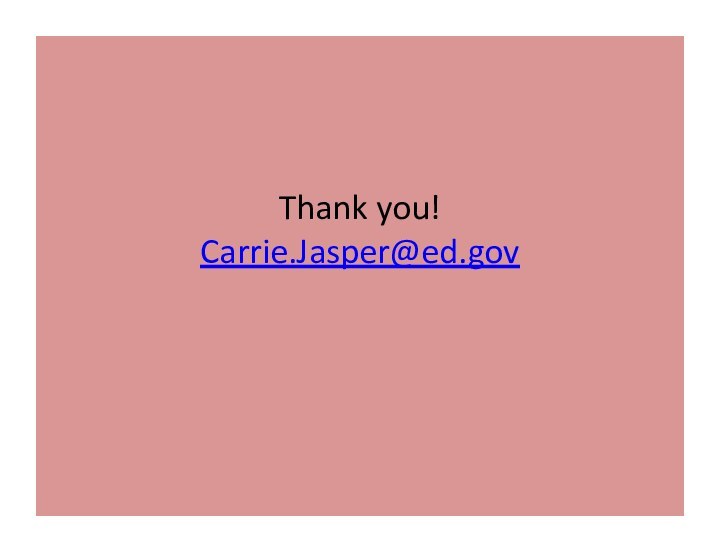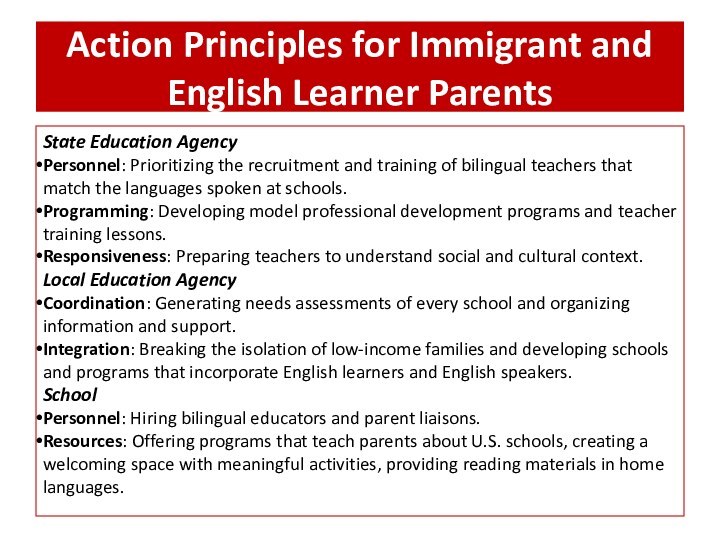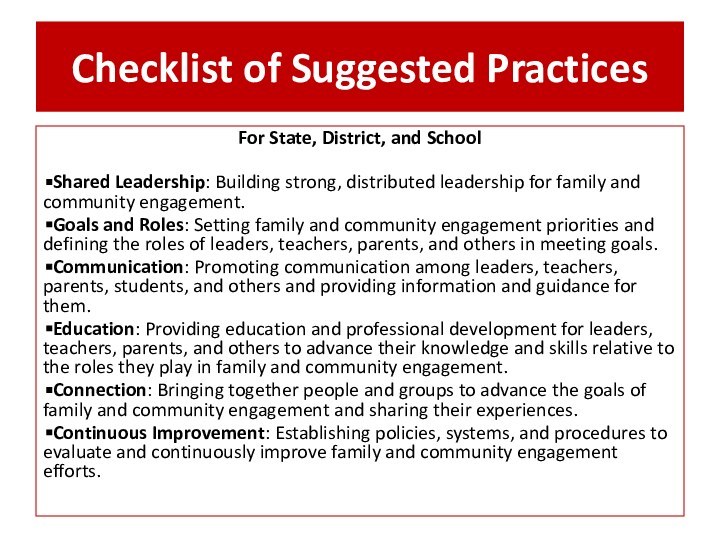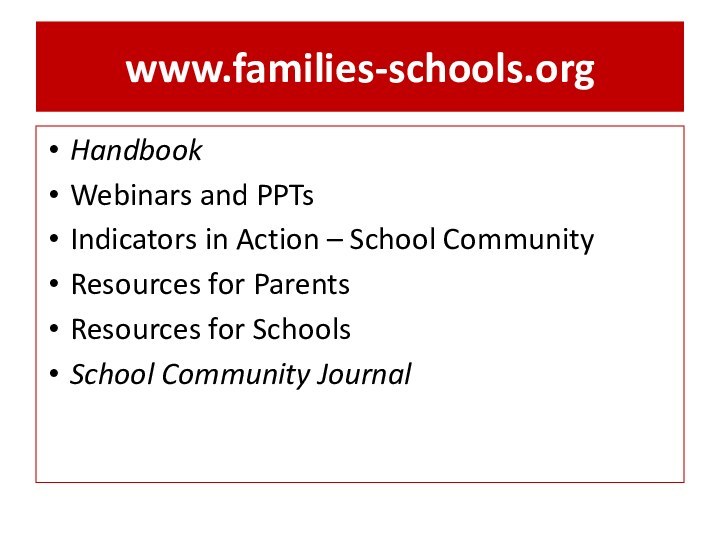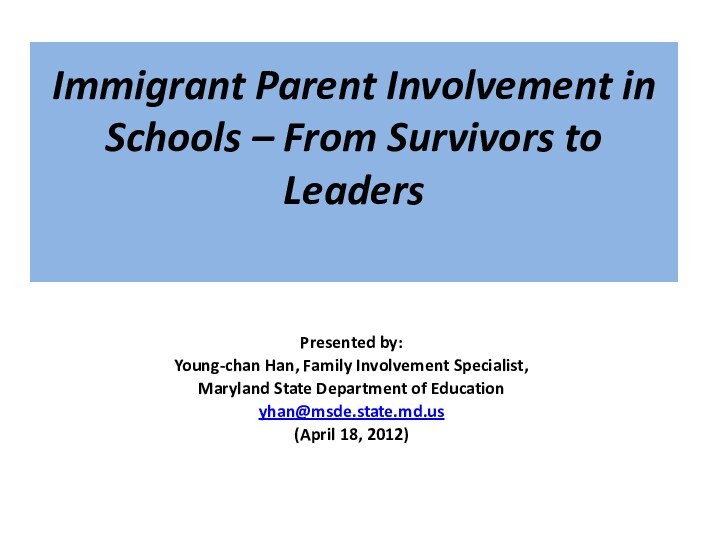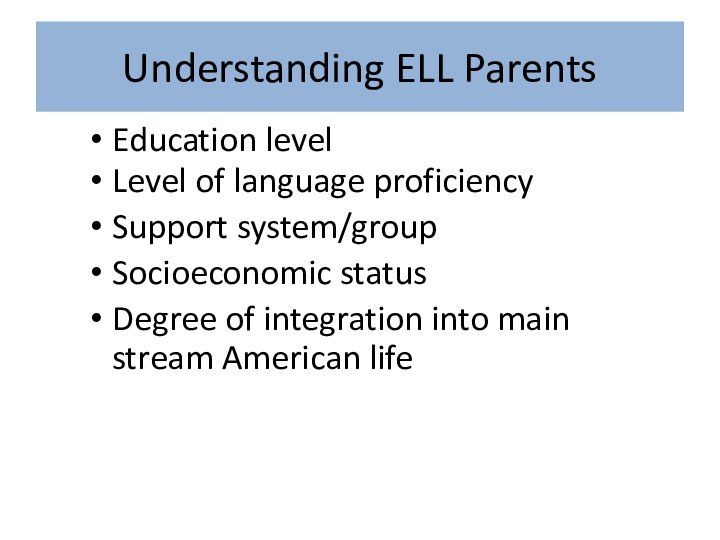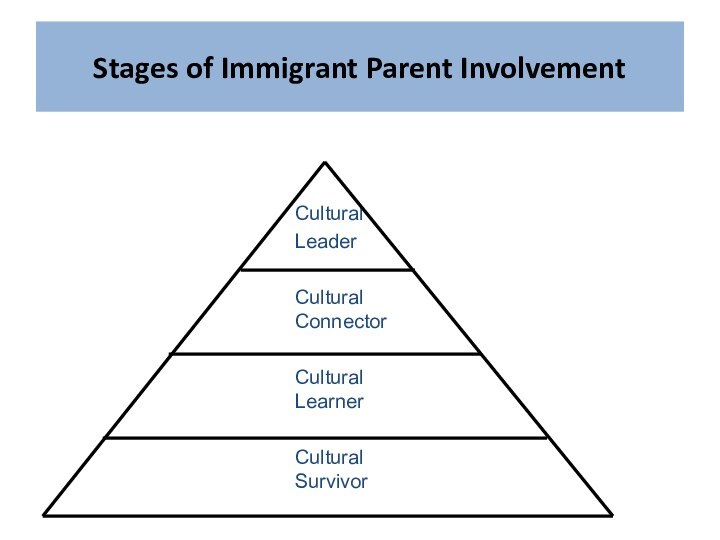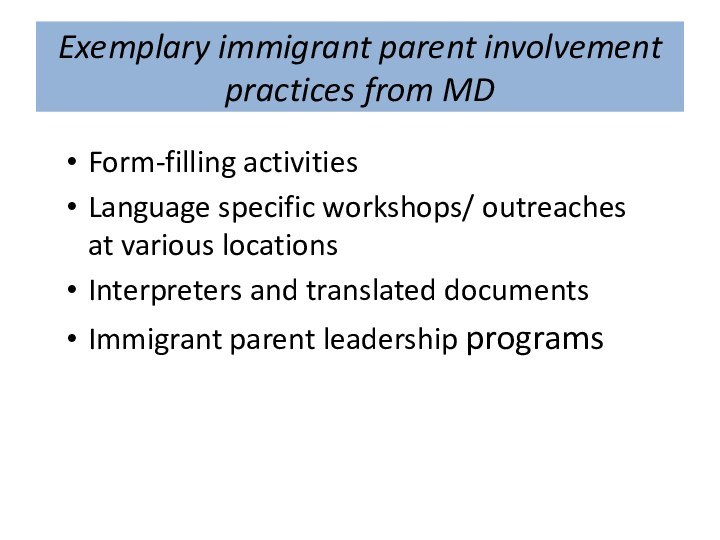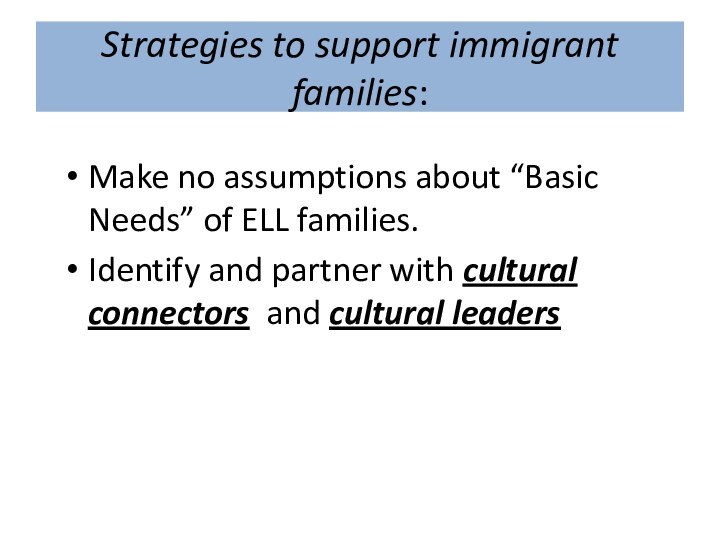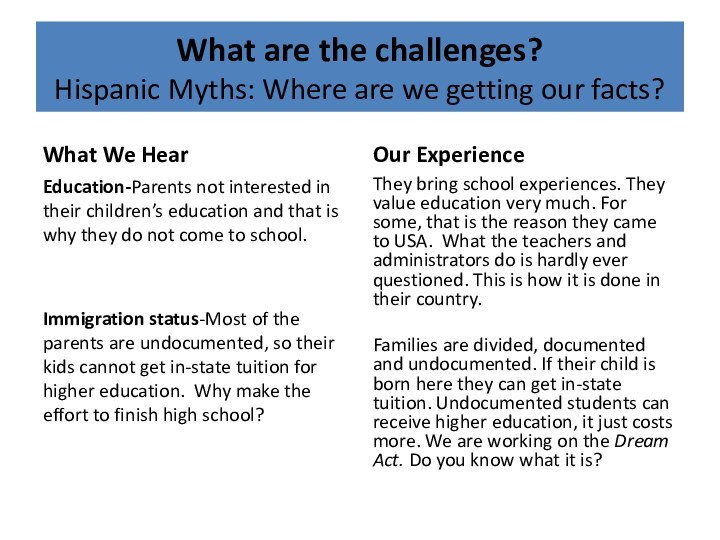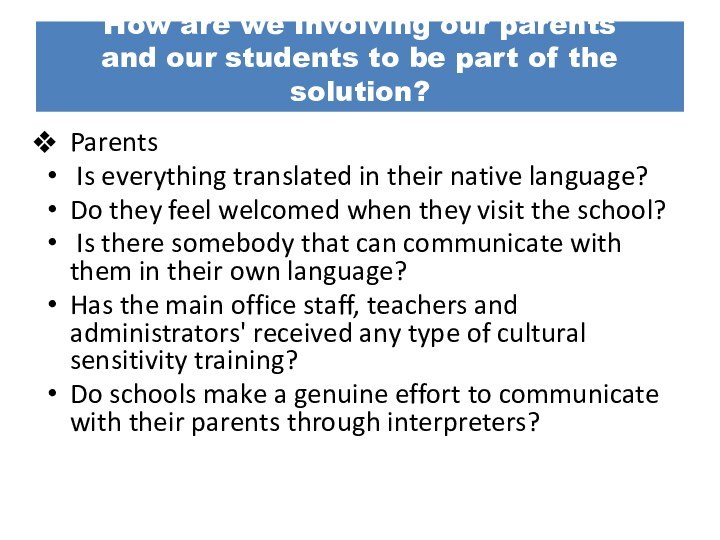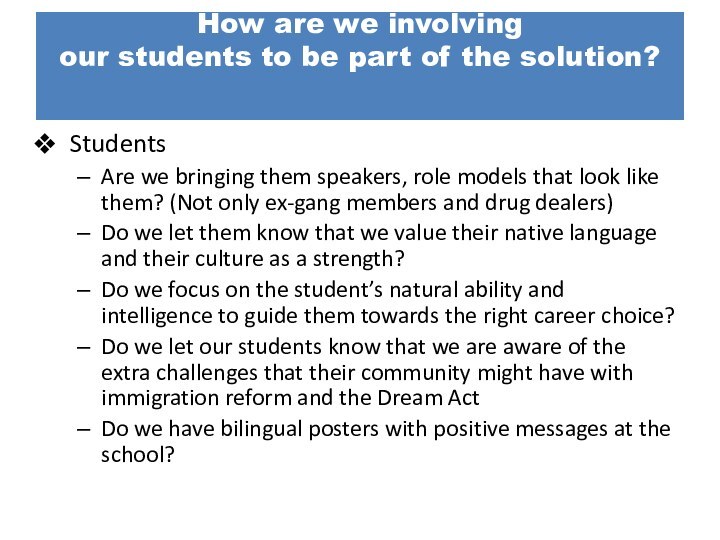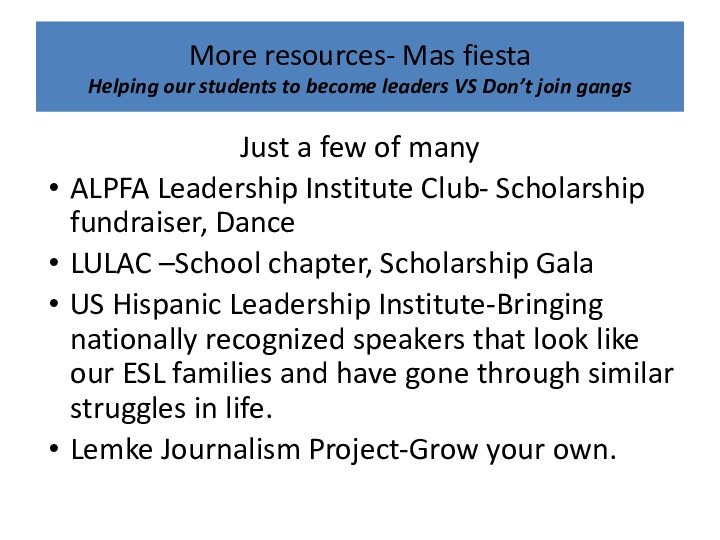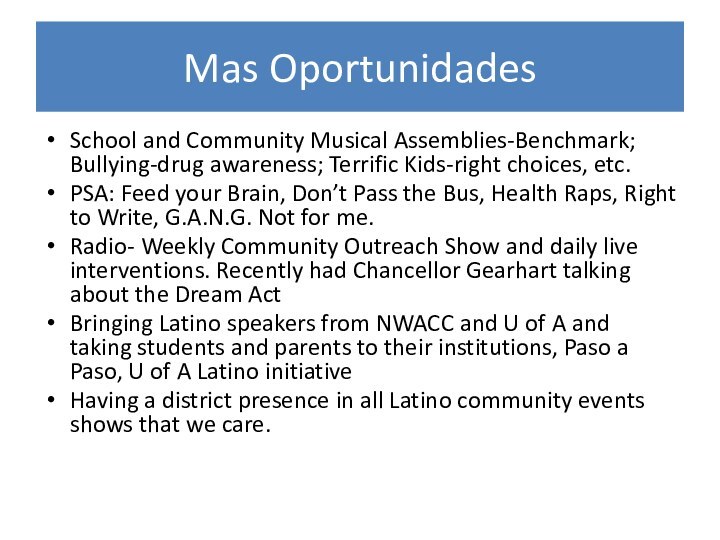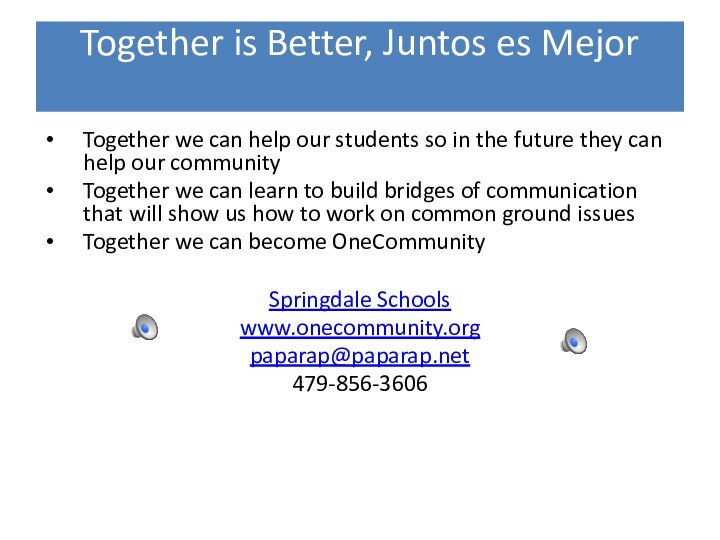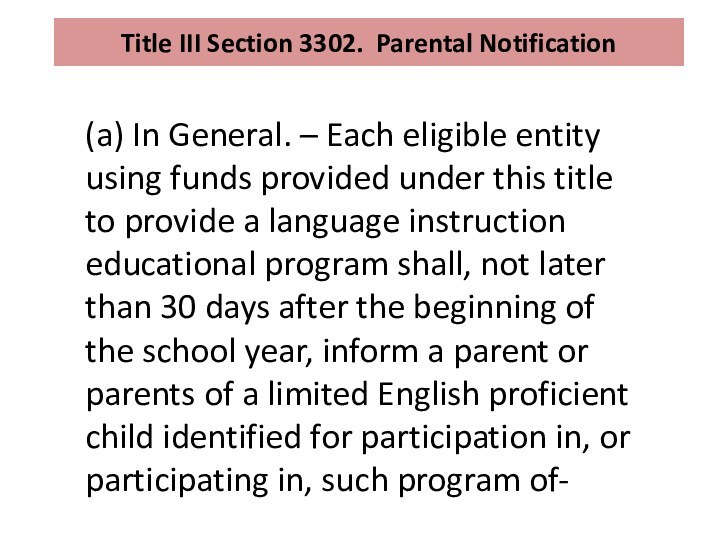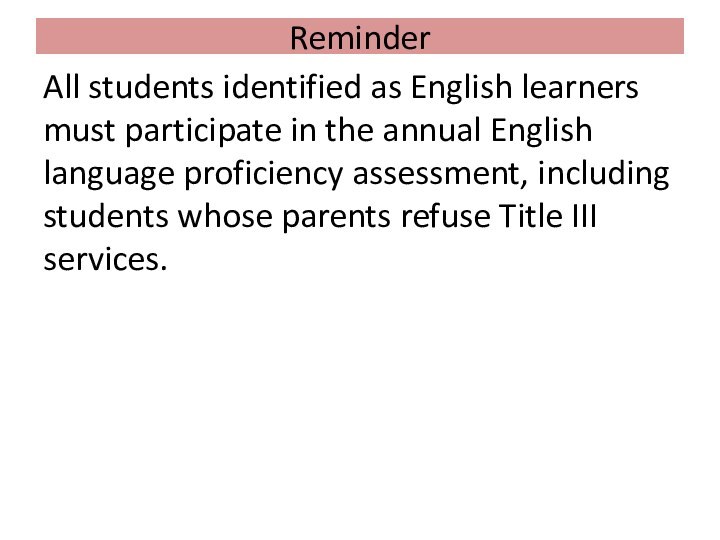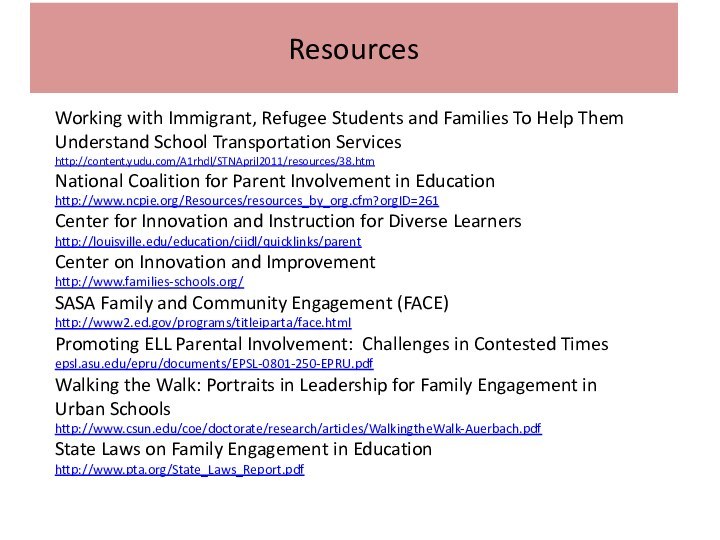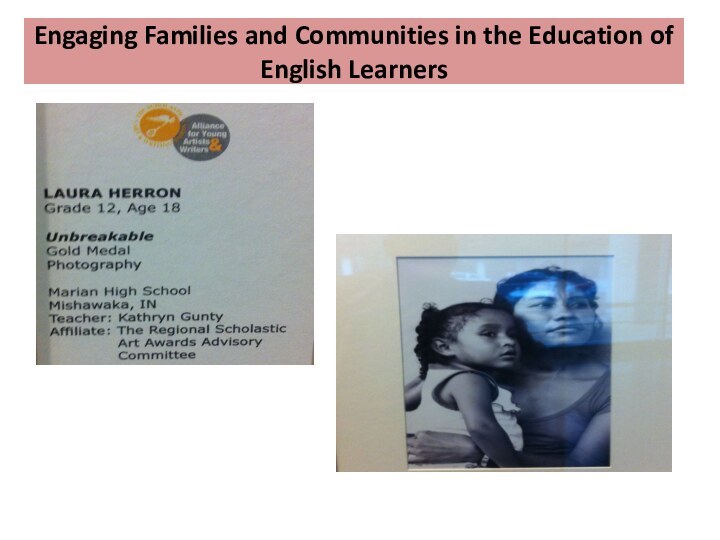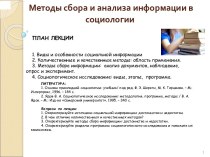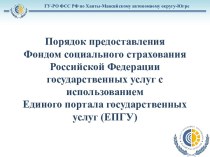Слайд 2
Introductions – Petraine Johnson
U. S. Department of Education
Family and Community Engagement Initiatives – Carrie Jasper
Handbook
on Family and Community Engagement – Sam Redding and Megan Hopkins
Immigrant Parent Involvement in Schools -
Young-Chan Han
Juntos es Mejor -Al “Papa Rap” Lopez
Parent Refusal of Services
Updates – Supreet Anand
Agenda
Слайд 3
Carrie Jasper
Office of Communications and Outreach
May 18, 2011
U.S
Department of Education (ED)
Family and Community Engagement Initiatives
Слайд 4
U.S. Department of Education
Family and Community Engagement
Initiatives
Family Engagement Team
Parent Outreach Interagency Team
Parent Forums
Other
ED Outreach and Technical Assistance Efforts
Слайд 5
Family Engagement Team
Office of Communications and Outreach
Team is composed of representatives from Region 1 (Boston),
Region IV (Atlanta), Region V (Chicago), Region VIII (Denver) and Region X (Seattle).
Members of the team respond to requests from States and hold parent forums and workshops for SEAs, LEAs, and parents.
Listen and learn sessions, roundtables, and meetings are also held to identify the needs and concerns of parents.
Слайд 6
Family Engagement Team Contacts
Carrie Jasper – Carrie.Jasper@ed.gov
Olga
Pirela (Boston) - Olga.Pirela@ed.gov
Jonava Johnson (Atlanta) – jonava.Johnson@ed.gov
Shirley Jones
(Chicago)- Shirley.Jones@ed.gov
Diana Huffman (Denver)- Diana.Huffman@ed.gov
Linda Pauley (Seattle) – Linda.Pauley@ed.gov
Слайд 7
ED’s Parent Outreach Interagency Team
Several offices across the
Department have partnered to bolster family and community engagement
outreach efforts:
Office of Elementary and Secondary Education
Office of Civil Rights
Office of Special Education and Rehabilitative Services
Office of Faith-based and Neighborhood Partnerships
Office of Early Learning
Office of Innovation and Improvement
Office of Communications and Outreach
Слайд 8
Parent Forums
Forum topics are based on feedback from
parents.
Previous topics include:
Special education
PIRCs
Civil rights
Resources available through
states
Bullying
Federal Student Aid
Section 1118 of the ESEA – Parental Involvement
Слайд 9
Parent forums are held in partnership with universities,
colleges, businesses, associations, organizations, school districts, and community groups.
ED
has also partnered with states, other government agencies and universities to hold workshops.
Parent Forums
Слайд 10
Parent Forum Goals
The goals of the parent forums
are to:
Inform parents of legislation that will influence their
children’s education,
Equip them with knowledge and skills to be advocates for their children,
Enable parents to become informed leaders and decision makers within their community, and
Open the lines of communication between educators and parents to alleviate barriers that exist because of miscommunication and misunderstandings.
Слайд 11
Forum Presenters
Presenters for the forums include staff from:
Parent Information Resource Centers
Regional Comprehensive Centers
Parent Training Institutes
Comprehensive Parent
Resource Centers
State education agencies
ED and other federal agencies.
Слайд 12
Other Outreach Efforts
The Parent Outreach Interagency Team
Produces
a quarterly newsletter, Engaging Parents, which encourages support of
family engagement to improve student achievement
Disseminates information to parents through a national parent listserv
Provides input for Touching Base, the Department's quarterly newsletter for the military community
Shares and develops parent resources and tools: http://www.edpubs.gov/
Слайд 13
Other Outreach Efforts - OSERS
In partnership with Office
of Communications and Outreach held the first in a
series of Webinars, Family Engagement and the Individuals With Disabilities Education Act, specifically for parents based upon their requests.
The May 2011 webinar is available at http://tadnet.org/news_posts/44 or the home page, tadnet.org.
Слайд 14
Other Outreach Efforts - SASA
FACE Team in
SASA, which includes representatives from Title III, Homeless Education,
Neglected & Delinquent Education and Title I, Part A.
Established a mailbox, FACE@ed.gov for information regarding family and community engagement activities specific to Title I Part A, Section 1118.
Partnered with the Academic Development Institute and Center on Innovation and Improvement to produce the Handbook on Family and Community Engagement.
Designated family engagement regional specialists in ED’s 16 Regional Comprehensive Centers.
Слайд 15
Other Outreach Efforts - OII
A series of Webinars
on family, school and community engagement. The recorded Webinars
can be found at: http://www.nationalpirc.org/engagement_webinars/archives.html
A Family, School and Community Engagement Summit in September 2010
Слайд 16
Other Outreach Efforts - OCO
Hosted a series of
policy briefings on family engagement
Established a parent mailbox, parent@ed.gov
to receive general comments, questions and requests from parents
Developed a webpage for Veterans and Military Families: http://www.ed.gov/veterans-and-military-families
Слайд 17
Thank you!
Carrie.Jasper@ed.gov
Слайд 18
Moving Beyond Parent Involvement to
Family & Community
Engagement:
A Handbook Linking Research and Practice
Sam Redding,
Center
on Innovation & Improvement
Слайд 19
What Is Family Engagement?
Families engaged with own children.
Families
engaged with families of other children.
Families engaged with their
children's’ school.
Слайд 20
What is Community Engagement?
School community – people intimately
associated with the school – students, families, teachers, staff,
volunteers.
Community resources to support the school and its families.
School attuned to diversity of surrounding community.
Слайд 21
Comprehensive Family Engagement
Leadership, structures (teams), systems (processes)
Doing many
things well over time
Ongoing conversation
Engaging families intentionally, with purpose
Connecting
to student learning (academic, social, emotional)
Adopting a “school community” approach
People intimately attached to the school
Relationships among all members—leaders, teachers, staff, parents, students, volunteers
Roles and responsibilities
Knowing each family’s story
Слайд 22
Student Learning Outcomes
Academic, Social, and Emotional Learning
What the
research tells us
Strong link between family and school learning
Curriculum
of the Home
Parental aspiration for children
Self-efficacy perception
Parents’
Students’
Слайд 23
Published in September 2011
36 experts contributed chapters
In partnership
with U. S. Department of Education – Title I
Download
free at: www.families-schools.org
Purchase published version from Information Age at: www.infoagepub.com
Handbook on Family and Community Engagement
Слайд 24
Why the Handbook?
Bring best research together in one
place
Add the wisdom of many voices
Present in a straight-forward
manner
Provide practical application
Include ample references and resources
Leaven with a dash of reality with vignettes
Слайд 25
How the Handbook is Organized
Introduction
Part I: Framing the
Discussion
Part II: Families and Learning
Part III: Families and Schools
Part
IV: Checklist of Suggested Practices
Vignettes
Слайд 26
Framing the Discussion
New Directions for Title I Family
Engagement: Lessons From the Past
Oliver C. Moles, Jr.
& Arnold F. Fege
The School Community: Working Together for Student Success
Sam Redding
Making Data Matter in Family Engagement
Heather Weiss & M. Elena Lopez
Engaging Families and Communities in School Turnarounds: When Students Can’t Wait
Lauren Morando Rhim
Social, Emotional, and Academic Learning: Complementary Goals for School–Family Partnerships
Amy Mart, Linda Dusenbury, & Roger P. Weissberg
Engaging the Entire Community: The Community Schools’ Way
Marty Blank
Слайд 27
Families and Learning
Aspiration and Expectations: Providing Pathways to
Tomorrow
William Jeynes
Self-Efficacy: Up to the Challenge
Kathleen
Hoover-Dempsey
Curriculum of the Home
Herbert J. Walberg
Homework and Study Habits
Lee Shumow
Engaging Families in Reading
Holly Kreider
Reading and Literacy
Diana Hiatt-Michael
College and Career Readiness
Mary R. Waters & John Mark Williams
Слайд 28
Families and Schools
A Framework for Partnerships - Steven
B. Sheldon
Parent Leadership - Anne T. Henderson &
Sam Redding
Maximum Homework Impact: Optimizing Time, Purpose, Communication, and Collaboration - Frances Van Voorhis
Differentiating Family Supports - Patricia Edwards
Bridging Language and Culture - Patricia Gándara
Minority Families and Schooling - Susan J. Paik
Association of Poverty With Family Relations and Children’s and Adolescents’ Socioemotional Adjustment - Ronald Taylor
Families of Children With Disabilities: Building School–Family Partnerships - Eva Patrikakou
Linking Schools to Early Childhood - Kate McGilly
Family Engagement in High Schools - Mavis Sanders
Family and Community Engagement in Charter Schools - Brian R. Beabout & Lindsey B. Jakiel
Family Engagement in Rural Schools - Amanda L. Witte & Susan M. Sheridan
Bridging Two Worlds for Native American Families - Pamela Sheley
Слайд 29
Engaging Immigrant and English Learner Parents
Low-income immigrant parents
often do not have the social capital or English
skills to navigate the U.S. education system.
Parents’ failure to come to school or to meet with teachers is often interpreted as “not caring,” yet research has shown that most care deeply about their children’s education and have high expectations for their children’s futures.
Bilingual teachers are important for helping connect immigrant parents to schools and converting high expectations into success.
Слайд 30
Bilingual Educators Facilitate Immigrant and EL Parent Engagement
Evidence
from a multi-state study showed that bilingual teachers were
.23 times more likely to reach out to parents of English learners informally.
These “curbside conversations” were key for developing relationships with parents and connecting them to school.
Twice as many bilingual teachers reported hearing from parents of English learners once a week or more, compared to non-bilingual teachers.
Bilingual teachers demonstrated a team approach to parent engagement, rather than relying on traditional forms of involvement.
Слайд 31
Action Principles for Immigrant and English Learner Parents
State
Education Agency
Personnel: Prioritizing the recruitment and training of bilingual
teachers that match the languages spoken at schools.
Programming: Developing model professional development programs and teacher training lessons.
Responsiveness: Preparing teachers to understand social and cultural context.
Local Education Agency
Coordination: Generating needs assessments of every school and organizing information and support.
Integration: Breaking the isolation of low-income families and developing schools and programs that incorporate English learners and English speakers.
School
Personnel: Hiring bilingual educators and parent liaisons.
Resources: Offering programs that teach parents about U.S. schools, creating a welcoming space with meaningful activities, providing reading materials in home languages.
Слайд 32
Checklist of Suggested Practices
For State, District, and School
Shared
Leadership: Building strong, distributed leadership for family and community
engagement.
Goals and Roles: Setting family and community engagement priorities and defining the roles of leaders, teachers, parents, and others in meeting goals.
Communication: Promoting communication among leaders, teachers, parents, students, and others and providing information and guidance for them.
Education: Providing education and professional development for leaders, teachers, parents, and others to advance their knowledge and skills relative to the roles they play in family and community engagement.
Connection: Bringing together people and groups to advance the goals of family and community engagement and sharing their experiences.
Continuous Improvement: Establishing policies, systems, and procedures to evaluate and continuously improve family and community engagement efforts.
Слайд 33
Vignettes
Jessica—William Jeynes
Annabelle—Marilyn Murphy
Tyler—Lee Shumow
Xiomara—Georganne Morin & Holly Kreider
Alicia and Dan—Diana Hiatt-Michael
Angela—Patricia Edwards
Billy—Sam Redding
Tony—Lori
G. Thomas
Marie—Pamela Sheley
Слайд 34
Family Engagement Regional Specialists
Alaska Regional Comprehensive Center -
Jerry Schoenberger
Appalachia Regional Comprehensive Center - Anita Deck
California Regional
Comprehensive Center - Maria Paredes
Florida and Islands Comprehensive Center - John Lockwood
Great Lakes East Comprehensive Center - Frank DeRosa
Great Lakes West Comprehensive Center - Caroline Wentzel
Mid‐Atlantic Comprehensive Center - Janet Brown
Mid‐Continent Comprehensive Center - Sharon Brooks
New England Comprehensive Center - Joe Trunk
New York Comprehensive Center - Crystal Francis
North Central Comprehensive Center - Jane Hill
Northwest Comprehensive Center - Deborah Davis
Pacific Comprehensive Center - Canisius Filibert
Southeast Comprehensive Center - Sally Wade
Southwest Comprehensive Center - Maria Paredes
Texas Comprehensive Center - Marion Baldwin
Слайд 35
www.families-schools.org
Handbook
Webinars and PPTs
Indicators in Action – School Community
Resources
for Parents
Resources for Schools
School Community Journal
Слайд 36
Parents Surveyed in 2007 National Household Education Survey
Parents

received note or email from school specifically about child………… 54%
Parents
received telephone contact from school…………………………………….. 49%
Parents received information about homework………………………………………. 83%
Parents received information about parents’ role in school…………………….. 86%
Parents attended PTO/PTA meeting at school…………………………………………. 89%
Parents attended parent-teacher conference (grades 9-12)……………………. 61%
Parents attended parent-teacher conference (grades K-2)……………………… 90%
Parents attended parent-teacher conference (grades 3-5)……………………… 92%
Parents attended parent-teacher conference (grades 6-8)……………………… 76%
Parents whose K-12 children do homework……………………………………………. 94%
Parents of K-12 students satisfied with school………………………………………… 59%
Parents satisfied with school staff-parent interactions……………………………. 55%
Parents reporting amount of homework “about right”……………………………. 75%
Parents who expect children to finish high school…………………………………… 99%
Parents who expect children to finish 4-year college……………………………….. 40%
Herrold, K., and O’Donnell, K. (2008). Parent and Family Involvement in Education, 2006–07 School Year, From the National Household Education Surveys Program of 2007 (NCES 2008-050). National Center for Education Statistics, Institute of Education Sciences, U.S. Department of Education. Washington, DC.
Families and Schools
Слайд 37
Contacts
Danita Woodley – danita.woodley@ed.gov
Sam Redding – sredding@centerii.org
Megan Hopkins
–
m-hopkins@northwestern.edu
Слайд 38
Immigrant Parent Involvement in Schools – From Survivors
to Leaders
Presented by:
Young-chan Han, Family Involvement Specialist,
Maryland State
Department of Education
yhan@msde.state.md.us
(April 18, 2012)
Слайд 39
Understanding ELL Parents
Education level
Level of language proficiency
Support system/group
Socioeconomic
status
Degree of integration into main stream American life
Слайд 40
Cultural
Leader
Cultural Connector
Cultural Learner
Cultural Survivor
Stages of Immigrant Parent
Involvement
Слайд 41
Key Points:
Immigrant families are a heterogeneous group.
Years
of residency in the US does NOT determine the
stage of involvement.
Parent involvement stages are fluid.
Support to immigrant families should be determined by their stages of parent involvement.
Cultural survivors need more intense support to meet basic needs.
Workshops and outreaches to parents need to look different at each stages.
Слайд 42
Exemplary immigrant parent involvement practices from MD
Form-filling
activities
Language specific workshops/ outreaches at various locations
Interpreters and translated
documents
Immigrant parent leadership programs
Слайд 43
Strategies to support immigrant families:
Make no assumptions about
“Basic Needs” of ELL families.
Identify and partner with
cultural connectors and cultural leaders
Слайд 44
References:
Roseberry-McKibbin, C. (1995). Increasing sensitivity to students and
families from multicultural backgrounds
Kugler, E. (2012). Innovative Voices in
Education: Engaging Diverse Communities.
Han, Y. (2012). “From Survivors to Leaders: Stages of Immigrant Parent Involvement in Schools”
Howard County Public School System, Maryland. www.hcpss.org
Слайд 45
Al “Papa Rap” Lopez
Community School Liaison
Springdale Public
Schools
Co-founder, OneCommunity
Together is better,
Juntos es mejor
Turning our challenges
into opportunities
Слайд 46
What are the challenges?
Hispanic Myths: Where are we
getting our facts?
What We Hear
Education-Parents not interested in their
children’s education and that is why they do not come to school.
Immigration status-Most of the parents are undocumented, so their kids cannot get in-state tuition for higher education. Why make the effort to finish high school?
Our Experience
They bring school experiences. They value education very much. For some, that is the reason they came to USA. What the teachers and administrators do is hardly ever questioned. This is how it is done in their country.
Families are divided, documented and undocumented. If their child is born here they can get in-state tuition. Undocumented students can receive higher education, it just costs more. We are working on the Dream Act. Do you know what it is?
Слайд 47
More Challenges-Colegio de la vida
What We Hear
Education Level-Parents
education level is very low so they cannot help
their kids with their homework.
Behaviors-Students are feeling disconnected- Joining gangs, very clannish, only want to speak Spanish.
Our Experience
In Mexico the law is free education until 9th grade- after that you are on your own and you have to pay for it.
Many times students are feeling lost with their identity. Looking to belong.
( Selena Movie) Feel hopeless because of parents sometimes being discriminated.
Parents have solutions, Uniforms./ College de la Vida
Слайд 48
How are we Involving our parents
and our
students to be part of the solution?
Parents
Is
everything translated in their native language?
Do they feel welcomed when they visit the school?
Is there somebody that can communicate with them in their own language?
Has the main office staff, teachers and administrators' received any type of cultural sensitivity training?
Do schools make a genuine effort to communicate with their parents through interpreters?
Слайд 49
How are we involving
our students to be
part of the solution?
Students
Are we bringing them speakers,
role models that look like them? (Not only ex-gang members and drug dealers)
Do we let them know that we value their native language and their culture as a strength?
Do we focus on the student’s natural ability and intelligence to guide them towards the right career choice?
Do we let our students know that we are aware of the extra challenges that their community might have with immigration reform and the Dream Act
Do we have bilingual posters with positive messages at the school?
Слайд 50
Some Community Resources:
El Gran Secreto: Childcare
Family literacy
program, 9 schools-200 parents graduate on May 4.
OneCommunity
program- PTLA-Parents Taking Leadership Action (PTLA) program
Mexican Consulate in LR - Plazas comunitarias, not only for Mexicans
Catholic Charities- Refer parents on immigration issues and train faculty
Francennette Herrera, Governors office
The Spanish and English Media- Bringing them the good stuff
Dr Andre Guerrero at the Arkansas Department of Education-Always there to help
City Government- Don’t Pass the Bus
Слайд 51
More resources- Mas fiesta
Helping our students to become
leaders VS Don’t join gangs
Just a few of many
ALPFA
Leadership Institute Club- Scholarship fundraiser, Dance
LULAC –School chapter, Scholarship Gala
US Hispanic Leadership Institute-Bringing nationally recognized speakers that look like our ESL families and have gone through similar struggles in life.
Lemke Journalism Project-Grow your own.
Слайд 52
Mas Oportunidades
School and Community Musical Assemblies-Benchmark; Bullying-drug
awareness; Terrific Kids-right choices, etc.
PSA: Feed your Brain, Don’t
Pass the Bus, Health Raps, Right to Write, G.A.N.G. Not for me.
Radio- Weekly Community Outreach Show and daily live interventions. Recently had Chancellor Gearhart talking about the Dream Act
Bringing Latino speakers from NWACC and U of A and taking students and parents to their institutions, Paso a Paso, U of A Latino initiative
Having a district presence in all Latino community events shows that we care.
Слайд 53
Together we can help our students so in
the future they can help our community
Together we can
learn to build bridges of communication that will show us how to work on common ground issues
Together we can become OneCommunity
Springdale Schools
www.onecommunity.org
paparap@paparap.net
479-856-3606
Together is Better, Juntos es Mejor
Слайд 54
Title III Section 3302. Parental Notification
(a) In General.
– Each eligible entity using funds provided under this
title to provide a language instruction educational program shall, not later than 30 days after the beginning of the school year, inform a parent or parents of a limited English proficient child identified for participation in, or participating in, such program of-
Слайд 55
(a) In General. – Each eligible entity using
funds provided under this title to provide a language
instruction educational program shall, not later than 30 days after the beginning of the school year, inform a parent or parents of a limited English proficient child identified for participation in, or participating in, such program of-
Title III Section 3302. Parental Notification
Слайд 56
(a)(8) information pertaining to parental rights that includes
written guidance –
detailing –
the right that parents have
to have their child immediately removed from such program upon their request; and
the options that parents have to decline to enroll their child in such program or to choose another program or method of instruction, if available; and
(B) assisting parents in selecting among various programs and methods of instruction, if more than one program or method is offered by the eligible entity.
Title III Section 3302. Parental Notification
Слайд 57
Questions
Have you met parents who did not want
their children enrolled in a language instruction educational program
(LIEP)?
What were the reasons they did not want their children enrolled in a LIEP?
What are some effective practices that LEAs can use to ensure parents have the information necessary to make informed decisions about their children’s education?
Слайд 58
Reminder
All students identified as English learners must participate
in the annual English language proficiency assessment, including students
whose parents refuse Title III services.
Слайд 59
Resources
Working with Immigrant, Refugee Students and Families To
Help Them Understand School Transportation Services http://content.yudu.com/A1rhdl/STNApril2011/resources/38.htm
National Coalition for
Parent Involvement in Education
http://www.ncpie.org/Resources/resources_by_org.cfm?orgID=261
Center for Innovation and Instruction for Diverse Learners
http://louisville.edu/education/ciidl/quicklinks/parent
Center on Innovation and Improvement
http://www.families-schools.org/
SASA Family and Community Engagement (FACE)
http://www2.ed.gov/programs/titleiparta/face.html
Promoting ELL Parental Involvement: Challenges in Contested Times
epsl.asu.edu/epru/documents/EPSL-0801-250-EPRU.pdf
Walking the Walk: Portraits in Leadership for Family Engagement in Urban Schools
http://www.csun.edu/coe/doctorate/research/articles/WalkingtheWalk-Auerbach.pdf
State Laws on Family Engagement in Education
http://www.pta.org/State_Laws_Report.pdf
